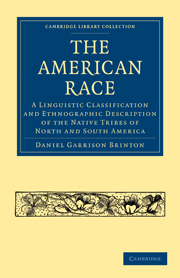 The American Race
The American Race I - THE NORTH ATLANTIC GROUP
Published online by Cambridge University Press: 29 August 2010
Summary
THE ESKIMOS
THE word Eskimo, properly Eski-mwhan, means in the Abnaki dialect of Algonquin, “he eats raw flesh,” and was applied to the tribe from its custom of consuming fish and game without cooking. They call themselves Innuit, “people,” a term the equivalent of which is the usual expression applied by American natives to their own particular stock.
The Innuit are at present essentially a maritime and arctic nation, occupying the coast and adjacent islands from the Straits of Belle Isle on the Atlantic to Icy Bay, at the foot of Mount St. Elias on the Pacific, and extending their wanderings and settlements as far up Smith's Sound as N. Lat. 80°, where they are by far the northernmost inhabitants of the earth. They have occupied Greenland for certainly more than a thousand years, and were the earliest settlers in some of the Aleutian islands. Portions of them at some remote period crossed Behring Strait and settled on Asiatic soil, while others established themselves along the shores of Newfoundland. Indeed, from the reports of the early Norse explorers and from the character of relics found on the Atlantic coast, it is probable that they once extended as far south as the mouth of the Delaware river. Their ancestors quite possibly dwelt on the moors of New England when the reindeer browsed there, and accompanied that quadruped in its final migration to the north. They belong in history and character to the Atlantic peoples.
- Type
- Chapter
- Information
- The American RaceA Linguistic Classification and Ethnographic Description of the Native Tribes of North and South America, pp. 59 - 102Publisher: Cambridge University PressPrint publication year: 2009First published in: 1891
